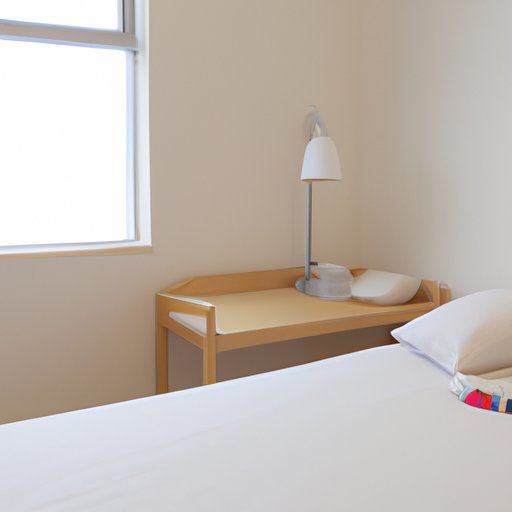Introduction
Setting up a personal care home bedroom can be a daunting task, but it doesn’t have to be. With some planning and creativity, you can create a comfortable, safe, and personalized space for yourself or your loved ones. In this article, we’ll explore five different approaches to setting up personal care home bedrooms, including tips, step-by-step guides, before-and-after galleries, Q&A with an expert, and a case study.
5 Tips for Setting Up Your Personal Care Home Bedroom
1. Arrange furniture for accessibility: make sure the room is easy to navigate with a mobility aid, such as a walker or wheelchair.
2. Choose bedding for comfort and ease of cleaning: select bedding that is soft, cozy, and easy to wash. Consider using waterproof mattress and pillow protectors for incontinence management.
3. Add personal touches: decorate the room with family photos, favorite books, and other items that bring joy and comfort.
4. Ensure good lighting: use a combination of overhead lights and task lights to provide adequate illumination for different activities.
5. Consider safety features: install grab bars near the bed, toilet, and shower/tub to prevent falls; use non-slip mats in the bathroom; and remove or secure loose rugs to prevent tripping.
Step-by-Step Guide to Setting Up Your Personal Care Home Bedroom
1. Assess the space: measure the room and make note of the dimensions, including window and door placements, electrical outlets, and any obstacles or potential hazards.
2. Plan the layout: determine the optimal placement of furniture, such as the bed, dresser, wardrobe, and seating area, based on accessibility and storage needs.
3. Choose furniture and fixtures: select appropriate pieces that fit the space and meet the occupant’s comfort and functional requirements. Look for features such as adjustable heights, easy-to-reach drawers, and sturdy materials.
4. Decorate the room: add personal touches, such as wall art, throw pillows, and bedding sets, that reflect the occupant’s personality and preferences. Stick to a cohesive color scheme and use accessories sparingly to avoid clutter.
5. Install safety features: affix grab bars, handrails, and non-slip mats in strategic locations, and make sure the room is well-lit with adequate lighting fixtures and outlets.
Transform Your Personal Care Home Bedroom – Before and After
Check out these impressive before-and-after photos of personal care home bedrooms that have been transformed with some creativity and effort:
1. Room A: This cluttered and cramped bedroom was transformed into a spacious and airy sanctuary by removing unnecessary furniture and repositioning the bed. The neutral color palette and natural lighting also contributed to a calming and restful atmosphere.
2. Room B: This outdated and dark bedroom underwent a complete makeover with new furniture, bedding, and wall decor. The bold pops of color and playful patterns helped to elevate the mood and inject some personality.
3. Room C: This cramped and cluttered bedroom was reorganized and optimized for accessibility by adding a hospital bed and installing grab bars and a lift system. The addition of personal touches such as family photos and a rocking chair also made the space feel more homey and inviting.
Ask the Expert – How to Create a Comfortable, Safe Personal Care Home Bedroom
Interior designer Jane Smith shares some insights and tips for creating a comfortable and safe personal care home bedroom:
1. What are some key considerations when selecting furniture for a personal care home bedroom?
A: Always prioritize functional and safety features, such as adjustable heights, sturdy frames, and non-slip surfaces. Look for pieces that are easy to clean and maintain, and that suit the occupant’s specific needs and preferences.
2. How can lighting be optimized in a personal care home bedroom?
A: Use a combination of task lighting and general illumination to create a balanced and versatile lighting scheme. Avoid harsh or dim lighting that can strain the eyes, and consider using dimmer switches or lamp shades to adjust the brightness as needed.
3. What are some common mistakes to avoid when setting up a personal care home bedroom?
A: Don’t neglect safety features, such as grab bars and non-slip mats, even if they may not seem aesthetically pleasing. Also, don’t overcrowd the room with too much furniture or decor; leave enough open space to accommodate a mobility aid and to facilitate easy movement.
The Perfect Personal Care Home Bedroom – A Real-Life Example
Meet Mrs. Johnson, a retired schoolteacher who recently moved into a personal care home following a health scare. Her son, Mark, worked with an interior designer to create the perfect bedroom for her:
1. Challenge: Limited Space. Solution: The designer decided to use an adjustable hospital bed that could be raised or lowered as needed to free up floor space. She also chose a dresser and wardrobe with vertical storage options to maximize storage capacity.
2. Challenge: Incontinence Management. Solution: The designer selected waterproof mattress and pillow protectors that could be easily removed and washed, and chose bedding sets made of moisture-wicking materials to promote airflow and discourage mold growth.
3. Challenge: Personal Touches. Solution: The designer worked with Mrs. Johnson and her family to decorate the room with items that held special meaning, such as a framed picture of her grandchildren and a quilt made by her mother. She also chose soothing colors and patterns that reflected Mrs. Johnson’s taste.
Conclusion
Setting up a personal care home bedroom can be a fun and rewarding project that helps to promote comfort, safety, and independence. Whether you’re looking for simple tips, step-by-step guides, inspiring before-and-after photos, expert advice, or real-life examples, there’s a solution for everyone.
(Note: Is this article not meeting your expectations? Do you have knowledge or insights to share? Unlock new opportunities and expand your reach by joining our authors team. Click Registration to join us and share your expertise with our readers.)
